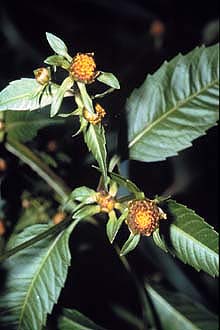
General Species Description
- Devil's Beggarticks are annual, erect, native herbaceous plants arising from a taproot. This plant ranges between 15 cm's up to 1.3 m in height. Bidens frondosa is weedy in appearance and extremely prolific. This species is one of the Bidens without ray flowers. It is identified by it's pinnately divided leaf segments, the 5-8 leafy bracts that appear beneath each flowering head, and the purple stems.
Leaves
- Leaves are opposite, pinnately divided into 3-7 segments, each segment up to 10 cm long and 5 cm wide. Leaflets are ovate to lanceolate, they may be glabrous to puberulent above, slightly pubescent beneath, they are acuminate and serrate. Petioles are 1-4 cm's long.
Inflorescence/Flowers
- There are many flowers to a head. Petals are yellow, about 4 mm long and come together to form a tube. Flowers are similar in appearance to the daisy. Flowers from August through October.
Fruits
- Achenes are flat, taper to a narrow base, and are dark colored. They may be smooth or hairy, and are approximately 6 mm long with a pair or barbed awns at the upper end which resemble the mouthparts of ticks. These barbs attach themselves to hair and clothing, hitching a ride with whoever, or whatever, is going by. This is how they got the name "beggarticks."
Habitat
- Devil's Beggarticks are found in a variety of locations, from fields to low woods, wet meadows, swamps and marshes, in roadside ditches, and around lakes and ponds. It is usually found in association with the smartweeds (Polygonum spp.), common Cattails (Typha latifolia), and the yellow Pond Lily (Nuphar luteum).
Range
- Bidens frondosa is found in all three western-most contiguous states. It is also found throughout most of the mid-west and virtually all of the northeast and the southeast.
Similar Species
- Devil's Beggarticks can be distinguished from it's most common cousin Bidens cernua - Nodding beggarticks) by the lack of ray flowers on frondosa, and the achenes with the two barbs (cernua has four barbs). The leaf shape is different for both as well, frondosa with sharply lanceolate leaflets and cernua with shorter, not quite as pointy tips and darker green leaflets.
Ecological Value
- Muskrats use the plant as a food source, and waterfowl eat the fruits.
Human Value
- Can be used as an educational aid, contributes free oxygen to the atmosphere, may be used as bedding for animals and transients.
- Cooke, S. S., ed.1997. A Field Guide to the Common Wetland Plants of Western Washington & Northwestern Oregon. Seattle Audubon Society and Washington Native Plant Society. Seattle Audubon Society, Seattle WA, 92pp. Guard, B. J., ed. 1995. Wetland Plants of Oregon & Washington. Lone Star Publishing, Richmond, WA 139pp. Website: http://plants.usda.gov/plants/fr_mapgen.cgi. Northern Prairie Wildlife Research Center.
This page was created by: Brook Holter, August 1999
Return to Northwest
Oregon Wetland Plants Project